Abstract
The Ah locus in the mouse controls the induction of cytochrome P1-450 and at least eleven associated monooxygenase activities. These enzyme systems metabolically potentiate and detoxify drugs, environmental pollutants, and other foreign chemicals, as well as numerous endogenous substrates. For certain substrates, it is known that cytochrome P1-450 produces different reactive intermediates and products that other forms of P-450. Alleles at the Ah locus can be identified in utero. Development toxicity (in the form of stillborns, resorptions, and malformations of the fetus) by 3-methylcholanthrene and 7,12-dimethylbenz[a]anthracene given to the pregnant mother is associated with genetically mediated aromatic hydrocarbon responsiveness in C5BL/6N mice, compared with that in nonresponsive AKR/N mice. Acetaminiphen-produced hepatic necrosis is associated with glutathione depletion in the liver, covalent binding of metabolite(s) of the drug to cellular macromolecules, and P1-450 induction controlled by the Ah locus. For reasons not known, the fetus and mice 10 days of age or less are relatively resistant to glutathione depletion and therefore hepatic necrosis by acetaminophen.
Full text
PDF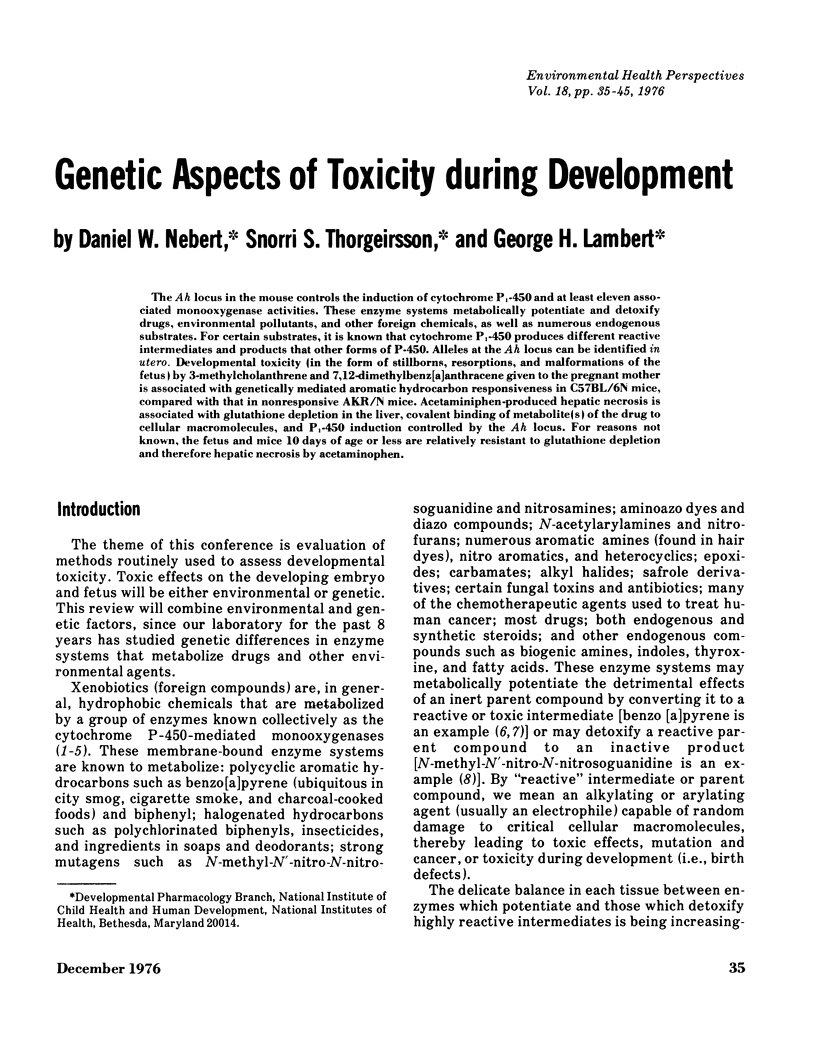


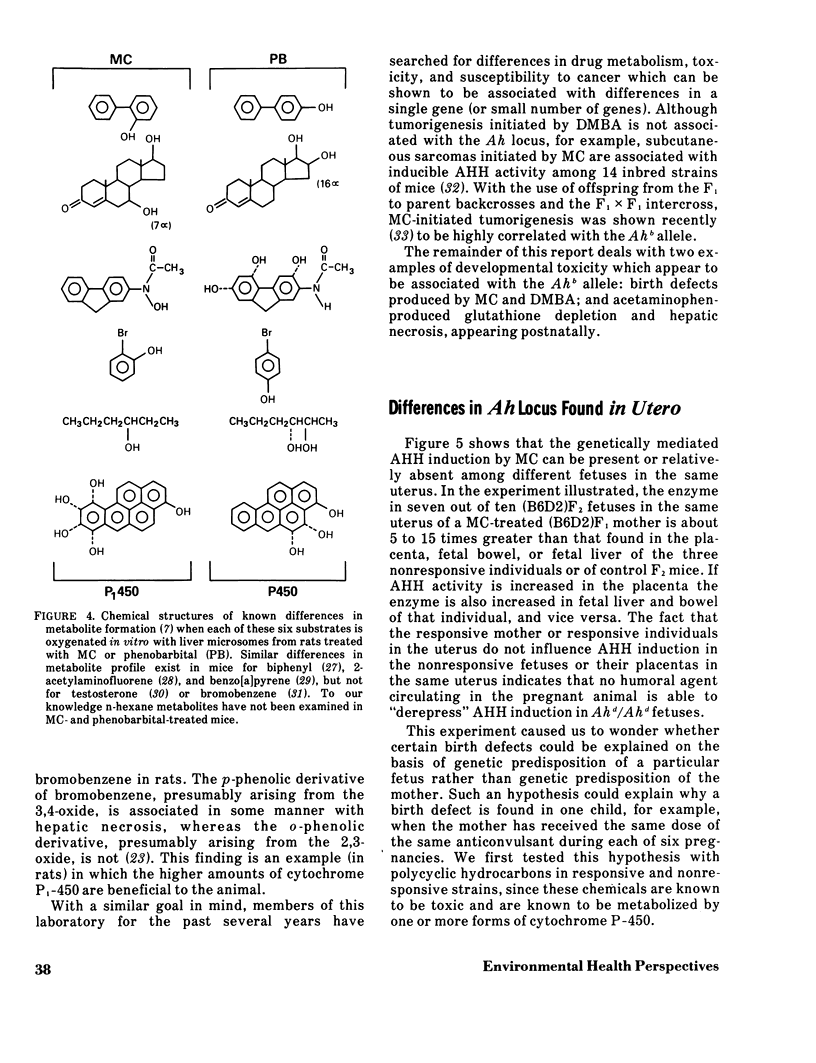
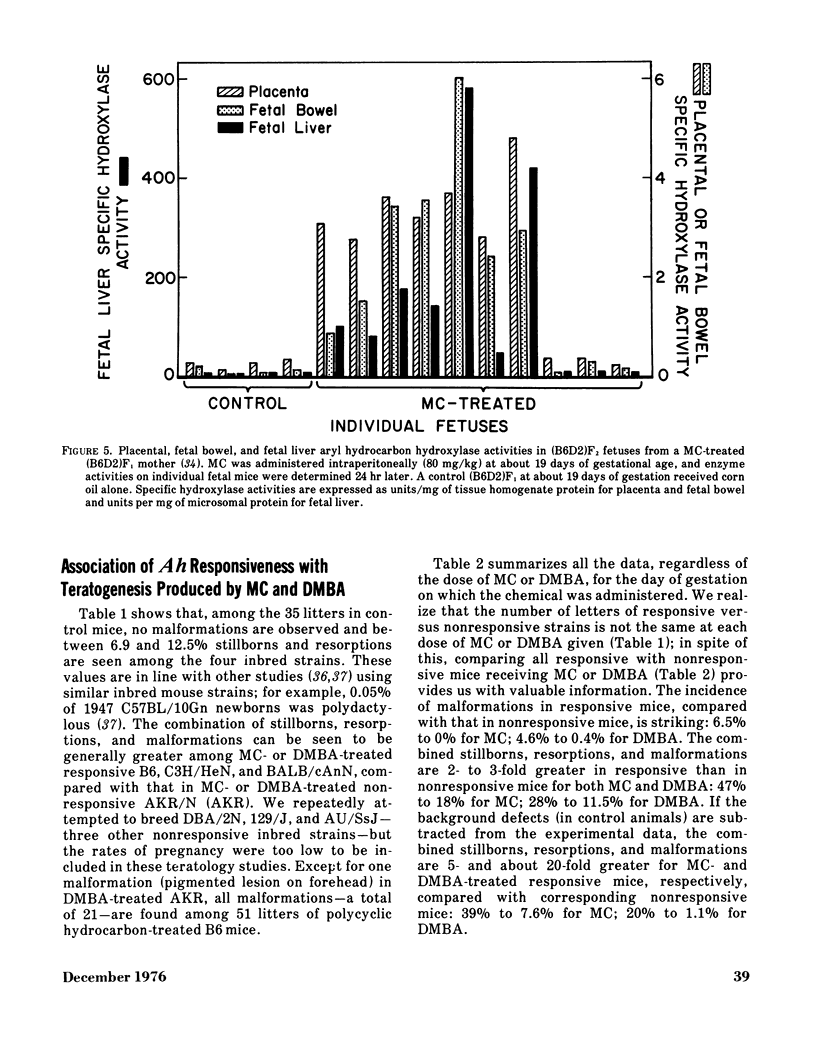
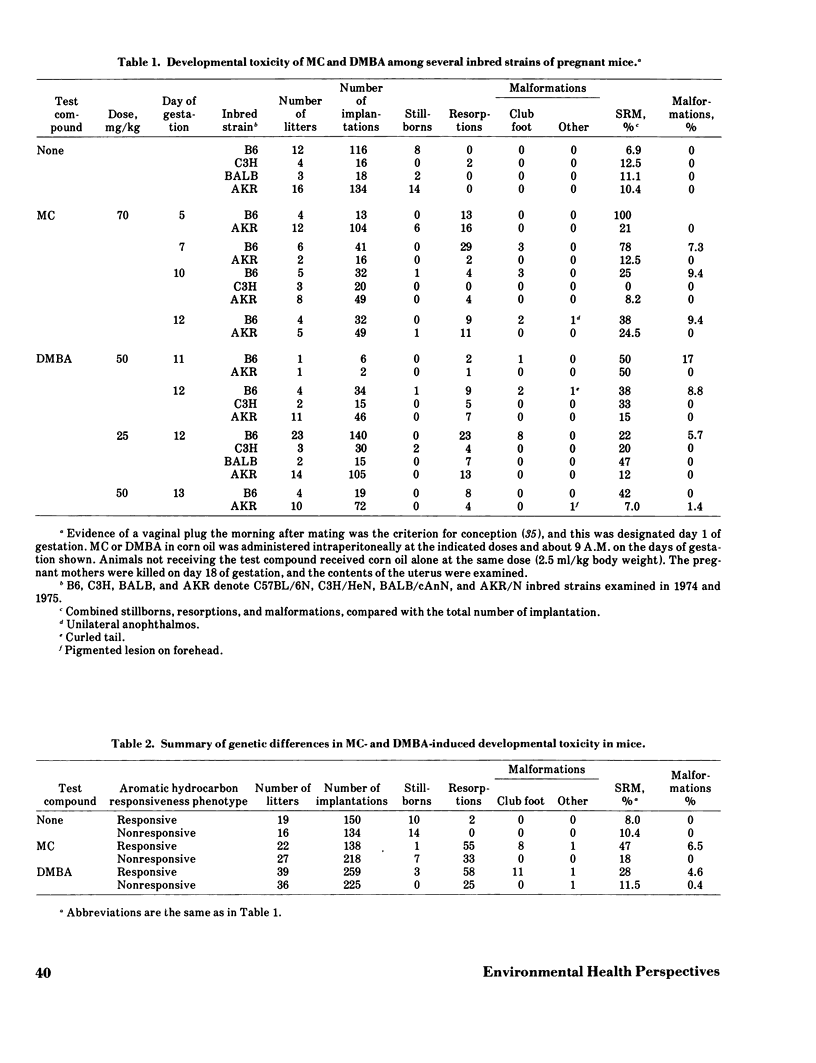
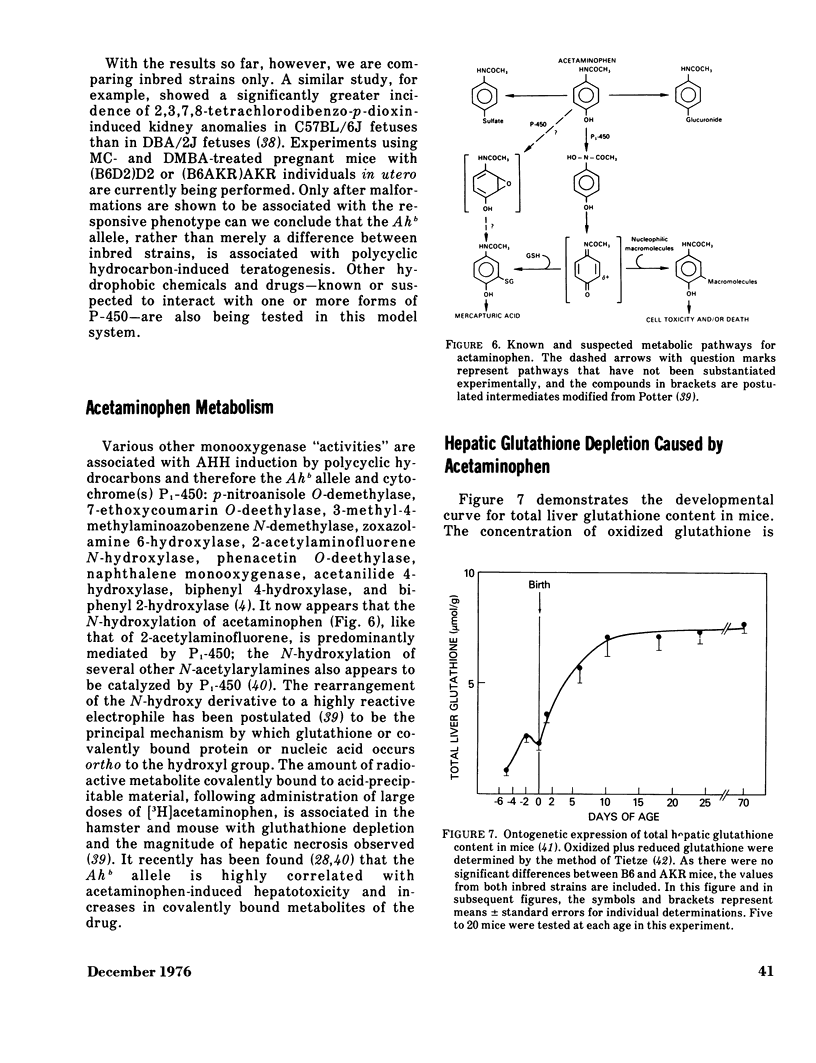


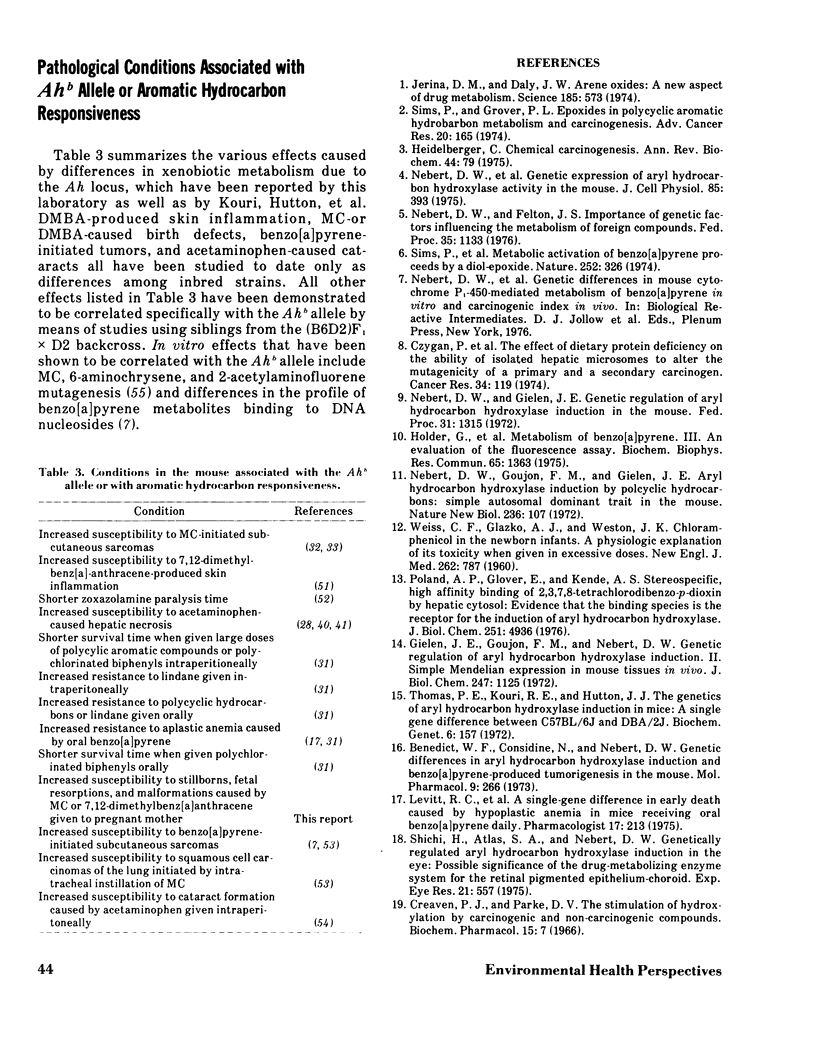
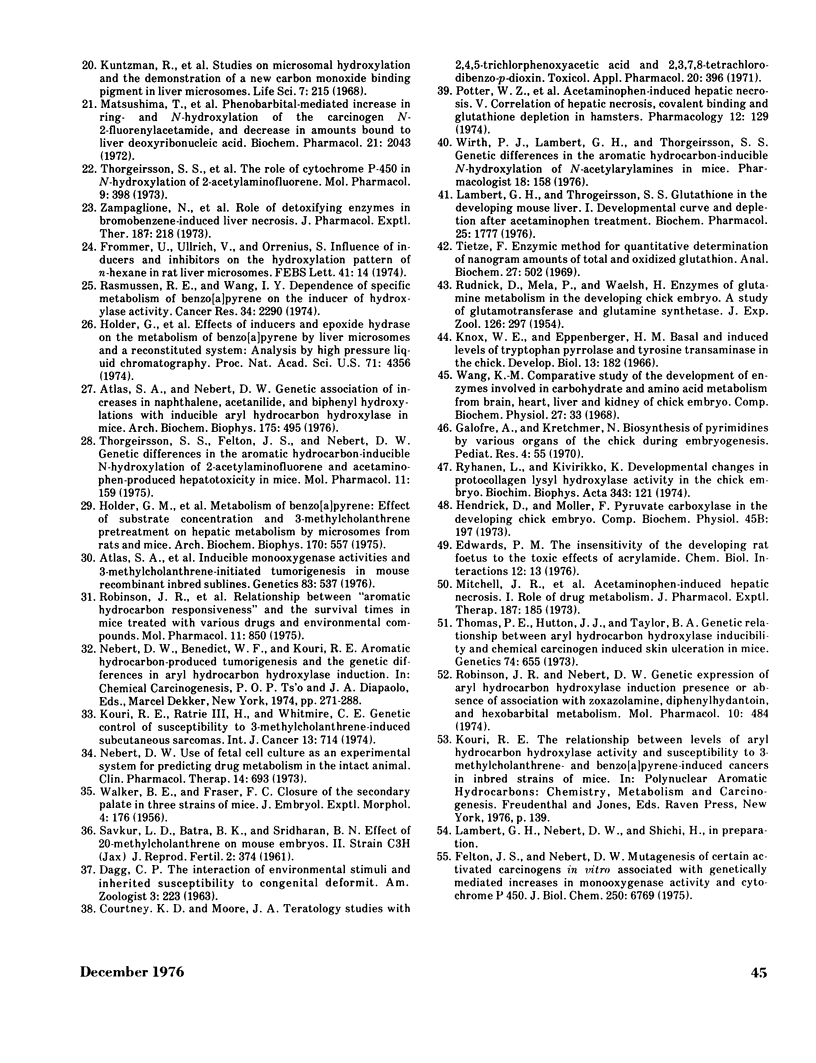
Selected References
These references are in PubMed. This may not be the complete list of references from this article.
- Atlas S. A., Nebert D. W. Genetic association of increases in naphthalene, acetanilide, and biphenyl hydroxylations with inducible aryl hydrocarbon hydroxylase in mice. Arch Biochem Biophys. 1976 Aug;175(2):495–506. doi: 10.1016/0003-9861(76)90537-3. [DOI] [PubMed] [Google Scholar]
- Atlas S. A., Taylor B. A., Diwan B. A., Nebert D. W. Inducible monooxygenase activities and 3-methyl-cholanthrene-initiated tumorigenesis in mouse recombinant inbred sublines. Genetics. 1976 Jul;83(3 PT2):537–550. [PMC free article] [PubMed] [Google Scholar]
- Benedict W. F., Considine N., Nebert D. W. Genetic differences in aryl hydrocarbon hydroxylase induction and benzo(a)pyrene-produced tumorigenesis in the mouse. Mol Pharmacol. 1973 Mar;9(2):266–277. [PubMed] [Google Scholar]
- Courtney K. D., Moore J. A. Teratology studies with 2,4,5-trichlorophenoxyacetic acid and 2,3,7,8-tetrachlorodibenzo-p-dioxin. Toxicol Appl Pharmacol. 1971 Nov;20(3):396–403. doi: 10.1016/0041-008x(71)90282-1. [DOI] [PubMed] [Google Scholar]
- Creaven P. J., Parke D. V. The stimulation of hydroxylation by carcinogenic and non-carcinogenic compounds. Biochem Pharmacol. 1966 Jan;15(1):7–18. doi: 10.1016/0006-2952(66)90105-5. [DOI] [PubMed] [Google Scholar]
- Czygan P., Greim H., Garro A., Schaffner F., Popper H. The effect of dietary protein deficiency on the ability of isolated hepatic microsomes to alter the mutagenicity of a primary and a secondary carcinogen. Cancer Res. 1974 Jan;34(1):119–123. [PubMed] [Google Scholar]
- Felton J. S., Nebert D. W. Mutagenesis of certain activated carcinogens in vitro associated with genetically mediated increases in monooxygenase activity and cytochrome P 1-450. J Biol Chem. 1975 Sep 10;250(17):6769–6778. [PubMed] [Google Scholar]
- Gielen J. E., Goujon F. M., Nebert D. W. Genetic regulation of aryl hydrocarbon hydroxylase induction. II. Simple Mendelian expression in mouse tissues in vivo. J Biol Chem. 1972 Feb 25;247(4):1125–1137. [PubMed] [Google Scholar]
- Heidelberger C. Chemical carcinogenesis. Annu Rev Biochem. 1975;44:79–121. doi: 10.1146/annurev.bi.44.070175.000455. [DOI] [PubMed] [Google Scholar]
- Holder G. M., Yagi H., Jerina D. M., Levin W., Lu A. Y., Conney A. H. Metabolism of benzo[a]pyrene. Effect of substrate concentration and 3-methylcholanthrene pretreatment on hepatic metabolism by microsomes from rats and mice. Arch Biochem Biophys. 1975 Oct;170(2):557–566. doi: 10.1016/0003-9861(75)90151-4. [DOI] [PubMed] [Google Scholar]
- Holder G., Yagi H., Dansette P., Jerina D. M., Levin W., Lu A. Y., Conney A. H. Effects of inducers and epoxide hydrase on the metabolism of benzo(a)pyrene by liver microsomes and a reconstituted system: analysis by high pressure liquid chromatography. Proc Natl Acad Sci U S A. 1974 Nov;71(11):4356–4360. doi: 10.1073/pnas.71.11.4356. [DOI] [PMC free article] [PubMed] [Google Scholar]
- Holder G., Yagi H., Levin W., Lu A. Y., Jerina D. M. Metabolism of benzo[a]pyrene. III. An evaluation of the fluorescence assay. Biochem Biophys Res Commun. 1975 Aug 18;65(4):1363–1370. doi: 10.1016/s0006-291x(75)80380-9. [DOI] [PubMed] [Google Scholar]
- Jerina D. M., Daly J. W. Arene oxides: a new aspect of drug metabolism. Science. 1974 Aug 16;185(4151):573–582. doi: 10.1126/science.185.4151.573. [DOI] [PubMed] [Google Scholar]
- Knox W. E., Eppenberger H. M. Basal and induced levels of tryptophan pyrrolase and tyrosine transaminase in the chick. Dev Biol. 1966 Apr;13(2):182–198. doi: 10.1016/0012-1606(66)90063-7. [DOI] [PubMed] [Google Scholar]
- Kouri R. E., Ratrie H., 3rd, Whitmire C. E. Genetic control of susceptibility to 3-methylcholanthrene-induced subcutaneous sarcomas. Int J Cancer. 1974 May 15;13(5):714–720. doi: 10.1002/ijc.2910130515. [DOI] [PubMed] [Google Scholar]
- Kuntzman R., Levin W., Jacobson M., Conney A. H. Studies on microsomal hydroxylation and the demonstration of a new carbon monoxide binding pigment in liver microsomes. Life Sci II. 1968 Feb 15;7(4):215–224. doi: 10.1016/0024-3205(68)90309-3. [DOI] [PubMed] [Google Scholar]
- Lambert G. H., Thorgeirsson S. S. Glutathione in the developing mouse liver--I. Developmental curve and depletion after acetaminophen treatment. Biochem Pharmacol. 1976 Aug 1;25(15):1777–1781. doi: 10.1016/0006-2952(76)90415-9. [DOI] [PubMed] [Google Scholar]
- Matsushima T., Grantham P. H., Weisburger E. K., Weisburger J. H. Phenobarbital-mediated increase in ring- and N-hydroxylation of the carcinogen N-2-fluorenylacetamide, and decrease in amounts bound to liver deoxyribonucleic acid. Biochem Pharmacol. 1972 Aug 1;21(15):2043–2051. doi: 10.1016/0006-2952(72)90158-x. [DOI] [PubMed] [Google Scholar]
- Mitchell J. R., Jollow D. J., Potter W. Z., Davis D. C., Gillette J. R., Brodie B. B. Acetaminophen-induced hepatic necrosis. I. Role of drug metabolism. J Pharmacol Exp Ther. 1973 Oct;187(1):185–194. [PubMed] [Google Scholar]
- Nebert D. W., Felton J. S. Importance of genetic factors influencing the metabolism of foreign compounds. Fed Proc. 1976 Apr;35(5):1133–1141. [PubMed] [Google Scholar]
- Nebert D. W., Gielen J. E. Genetic regulation of aryl hydrocarbon hydroxylase induction in the mouse. Fed Proc. 1972 Jul-Aug;31(4):1315–1325. [PubMed] [Google Scholar]
- Nebert D. W., Goujon F. M., Gielen J. E. Aryl hydrocarbon hydroxylase induction by polycyclic hydrocarbons: simple autosomal dominant trait in the mouse. Nat New Biol. 1972 Mar 29;236(65):107–110. doi: 10.1038/newbio236107a0. [DOI] [PubMed] [Google Scholar]
- Nebert D. W., Robinson J. R., Niwa A., Kumaki K., Poland A. P. Genetic expression of aryl hydrocarbon hydroxylase activity in the mouse. J Cell Physiol. 1975 Apr;85(2 Pt 2 Suppl 1):393–414. doi: 10.1002/jcp.1040850407. [DOI] [PubMed] [Google Scholar]
- Nebert D. W. Use of fetal cell culture as an experimental system for predicting drug metabolism in the intact animal. Clin Pharmacol Ther. 1973 Jul-Aug;14(4):693–699. doi: 10.1002/cpt1973144part2693. [DOI] [PubMed] [Google Scholar]
- Poland A., Glover E., Kende A. S. Stereospecific, high affinity binding of 2,3,7,8-tetrachlorodibenzo-p-dioxin by hepatic cytosol. Evidence that the binding species is receptor for induction of aryl hydrocarbon hydroxylase. J Biol Chem. 1976 Aug 25;251(16):4936–4946. [PubMed] [Google Scholar]
- Potter W. Z., Thorgeirsson S. S., Jollow D. J., Mitchell J. R. Acetaminophen-induced hepatic necrosis. V. Correlation of hepatic necrosis, covalent binding and glutathione depletion in hamsters. Pharmacology. 1974;12(3):129–143. doi: 10.1159/000136531. [DOI] [PubMed] [Google Scholar]
- Rasmussen R. E., Wang I. Y. Dependence of specific metabolism of benzo(a)pyrene on the inducer of hydroxylase activity. Cancer Res. 1974 Sep;34(9):2290–2295. [PubMed] [Google Scholar]
- Robinson J. R., Felton J. S., Levitt R. C., Thorgeirsson S. S., Nebert D. W. Relationship between "aromatic hydrocarbon responsiveness" and the survival times in mice treated with various drugs and environmental compounds. Mol Pharmacol. 1975 Nov;11(6):850–865. [PubMed] [Google Scholar]
- Robinson J. R., Nebert D. W. Genetic expression of aryl hydrocarbon hydroxylase induction. Presence or absence of association with zoxazolamine, diphenylhydantoin, and hexobarbital metabolism. Mol Pharmacol. 1974 May;10(3):484–493. [PubMed] [Google Scholar]
- Ryhänen L., Kivirikko K. I. Developmental changes in protocollagen lysyl hydroxylase activity in the chick embryo. Biochim Biophys Acta. 1974 Mar 20;343(1):121–128. doi: 10.1016/0304-4165(74)90243-8. [DOI] [PubMed] [Google Scholar]
- SAVKUR L. D., BATRA B. K., SRIDHARAN B. N. Effect of 20-methylcholanthrene on mouse embryos. II. Strain C3H (JAX). J Reprod Fertil. 1961 Nov;2:374–380. doi: 10.1530/jrf.0.0020374. [DOI] [PubMed] [Google Scholar]
- Shichi H., Atlas S. A., Nebert D. W. Genetically regulated aryl hydrocarbon hydroxylase induction in the eye: possible significance of the drug-metabolizing enzyme system for the retinal pigmented epithelium-choroid. Exp Eye Res. 1975 Dec;21(6):557–567. doi: 10.1016/0014-4835(75)90038-x. [DOI] [PubMed] [Google Scholar]
- Sims P., Grover P. L. Epoxides in polycyclic aromatic hydrocarbon metabolism and carcinogenesis. Adv Cancer Res. 1974;20:165–274. doi: 10.1016/s0065-230x(08)60111-6. [DOI] [PubMed] [Google Scholar]
- Sims P., Grover P. L., Swaisland A., Pal K., Hewer A. Metabolic activation of benzo(a)pyrene proceeds by a diol-epoxide. Nature. 1974 Nov 22;252(5481):326–328. doi: 10.1038/252326a0. [DOI] [PubMed] [Google Scholar]
- Thomas P. E., Hutton J. J., Taylor B. A. Genetic relationship between aryl hydrocarbon hydroxylase inducibility and chemical carcinogen induced skin ulceration in mice. Genetics. 1973 Aug;74(4):655–659. doi: 10.1093/genetics/74.4.655. [DOI] [PMC free article] [PubMed] [Google Scholar]
- Thomas P. E., Kouri R. E., Hutton J. J. The genetics of aryl hydrocarbon hydroxylase induction in mice: a single gene difference between C57BL-6J and DBA-2J. Biochem Genet. 1972 Apr;6(2):157–168. doi: 10.1007/BF00486400. [DOI] [PubMed] [Google Scholar]
- Thorgeirsson S. S., Felton J. S., Nebert D. W. Genetic differences in the aromatic hydrocarbon-inducible n-hydroxylation of 2-acetylaminofluorene and acetaminophen-produced hepatotoxicity in mice. Mol Pharmacol. 1975 Mar;11(2):159–165. [PubMed] [Google Scholar]
- Thorgeirsson S. S., Jollow D. J., Sasame H. A., Green I., Mitchell J. R. The role of cytochrome P-450 in N-hydroxylation of 2-acetylaminofluorene. Mol Pharmacol. 1973 May;9(3):398–404. [PubMed] [Google Scholar]
- Tietze F. Enzymic method for quantitative determination of nanogram amounts of total and oxidized glutathione: applications to mammalian blood and other tissues. Anal Biochem. 1969 Mar;27(3):502–522. doi: 10.1016/0003-2697(69)90064-5. [DOI] [PubMed] [Google Scholar]
- WEISS C. F., GLAZKO A. J., WESTON J. K. Chloramphenicol in the newborn infant. A physiologic explanation of its toxicity when given in excessive doses. N Engl J Med. 1960 Apr 21;262:787–794. doi: 10.1056/NEJM196004212621601. [DOI] [PubMed] [Google Scholar]
- Zampaglione N., Jollow D. J., Mitchell J. R., Stripp B., Hamrick M., Gillette J. R. Role of detoxifying enzymes in bromobenzene-induced liver necrosis. J Pharmacol Exp Ther. 1973 Oct;187(1):218–227. [PubMed] [Google Scholar]


